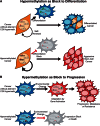Genomic insights into cancer-associated aberrant CpG island hypermethylation
- PMID: 23341493
- PMCID: PMC3662888
- DOI: 10.1093/bfgp/els063
Genomic insights into cancer-associated aberrant CpG island hypermethylation
Abstract
Carcinogenesis is thought to occur through a combination of mutational and epimutational events that disrupt key pathways regulating cellular growth and division. The DNA methylomes of cancer cells can exhibit two striking differences from normal cells; a global reduction of DNA methylation levels and the aberrant hypermethylation of some sequences, particularly CpG islands (CGIs). This aberrant hypermethylation is often invoked as a mechanism causing the transcriptional inactivation of tumour suppressor genes that directly drives the carcinogenic process. Here, we review our current understanding of this phenomenon, focusing on how global analysis of cancer methylomes indicates that most affected CGI genes are already silenced prior to aberrant hypermethylation during cancer development. We also discuss how genome-scale analyses of both normal and cancer cells have refined our understanding of the elusive mechanism(s) that may underpin aberrant CGI hypermethylation.
Keywords: CpG islands; DNA methylation; cancer; epigenetics; epigenomics.
Figures




Similar articles
-
Aberrant methylation and silencing of ARHI, an imprinted tumor suppressor gene in which the function is lost in breast cancers.Cancer Res. 2003 Jul 15;63(14):4174-80. Cancer Res. 2003. PMID: 12874023
-
CpG island hypermethylation and tumor suppressor genes: a booming present, a brighter future.Oncogene. 2002 Aug 12;21(35):5427-40. doi: 10.1038/sj.onc.1205600. Oncogene. 2002. PMID: 12154405 Review.
-
Deficiency of the Polycomb Protein RYBP and TET Methylcytosine Oxidases Promotes Extensive CpG Island Hypermethylation and Malignant Transformation.Cancer Res. 2023 Aug 1;83(15):2480-2495. doi: 10.1158/0008-5472.CAN-23-0269. Cancer Res. 2023. PMID: 37272752 Free PMC article.
-
Differential regulation of CpG island methylation within divergent and unidirectional promoters in colorectal cancer.Cancer Sci. 2019 Mar;110(3):1096-1104. doi: 10.1111/cas.13937. Epub 2019 Mar 2. Cancer Sci. 2019. PMID: 30637877 Free PMC article.
-
Comparison of genome-wide analysis techniques to DNA methylation analysis in human cancer.J Cell Physiol. 2018 May;233(5):3968-3981. doi: 10.1002/jcp.26176. Epub 2017 Oct 4. J Cell Physiol. 2018. PMID: 28888056 Review.
Cited by
-
Breast Cancer and Tamoxifen: A Nigerian Perspective to Effective Personalised Therapy.Breast Cancer (Dove Med Press). 2020 Oct 7;12:123-130. doi: 10.2147/BCTT.S266314. eCollection 2020. Breast Cancer (Dove Med Press). 2020. PMID: 33116814 Free PMC article. Review.
-
Mutations in Cancer Cause Gain of Cysteine, Histidine, and Tryptophan at the Expense of a Net Loss of Arginine on the Proteome Level.Biomolecules. 2017 Jul 3;7(3):49. doi: 10.3390/biom7030049. Biomolecules. 2017. PMID: 28671612 Free PMC article.
-
Using human disease mutations to understand de novo DNA methyltransferase function.Biochem Soc Trans. 2024 Oct 30;52(5):2059-2075. doi: 10.1042/BST20231017. Biochem Soc Trans. 2024. PMID: 39446312 Free PMC article. Review.
-
LINE1 methylation levels in pre-diagnostic leukocyte DNA and future renal cell carcinoma risk.Epigenetics. 2015;10(4):282-92. doi: 10.1080/15592294.2015.1006505. Epub 2015 Feb 3. Epigenetics. 2015. PMID: 25647181 Free PMC article.
-
Reshaping the Landscape of the Genome: Toolkits for Precise DNA Methylation Manipulation and Beyond.JACS Au. 2023 Dec 21;4(1):40-57. doi: 10.1021/jacsau.3c00671. eCollection 2024 Jan 22. JACS Au. 2023. PMID: 38274248 Free PMC article. Review.
References
Publication types
MeSH terms
Grants and funding
LinkOut - more resources
Full Text Sources
Other Literature Sources

